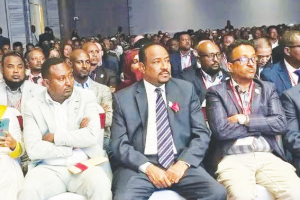
St. George Museum is located near the northern entrance of the St. George Church. Visitors are allowed to go into the museum with a fee. A notice put up at the entrance states that no use of the camera or any kind of recording is allowed. The museum contains the following:
Abune Petros Monument: The monument of the Abune Petrose is found in the courtyard of the museum on the right side of the entrance. It was the old monument of the Martyr who was killed during the Fascist Occupation for preaching resistance against the Fascist army. It was made by Greek and Armenian sculptors. They tell about Martyr.
Bell: A bell is found just at the door of the museum. The bell is said to be 104 years old and the gift of Czar Nicholas of Russia.
Pictures: The first series of pictures show the founding of St. George Church inside a thatched roof house in the reign of Emperor Menelik II. Priests carrying the Ark are said to have taken part with the Emperor in the Adwa Campaign. The victory of Adwa won on a Sunday in 1896 is believed by some to have been accomplished by the grace of St. George.
Church Building: The construction of the church was accomplished with the participation of Indians, Greeks and Armenian Architects. The construction work began in 1896. Exact date has not been given as regards the inauguration. It was reported that the church was partly burnt in 1937 at the time of the Yekatit Massacre when Italian solders perpetrated indiscriminate killings against Ethiopians following an attempt on the life of Griazzani.
Menelik’s Monument: The old monument was facing another direction. It was demolished and buried by the Fascist occupation force. The present monument constructed at the square outside the eastern gate of the church faces towards the north, The Square is now known as the Adwa Square (formerly Arada) is the site where the victory of the Battle of Adwa is commemorated every year.
Historical Figures: Several historical figures are represented in pictures and painting inside the museum. They include:
Emperor Menelik II, whose painting is displayed in a portrait form, there are also pictures of Queen Taitu Bitul, Queen Zewditu, Emperor Haile Selassie, Abune Matheos (the Coptic Patriarch), Abune Basleos, the first Ethiopian Patriarch and Fitawrari Habete Giorgis Dinegde, whose remains were buried behind the church museum.
Holy Materials: These include procession crosses, chalices, sistra (instrument used I church songs and chants), prayer staff and prayer books and Holy Scriptures.
Pages of the Holy Bible, the sinkisar and other well-known books traditionally produced in manuscript or parchment form have been displayed. They represent the rich religious literature of the Ethiopian Orthodox Church. Its literature and music are combined in St. Yared, whose work contains the Digua, which is said to take some two years to write by hand and four years to learn.
Gifts: The museum possesses gifts of paintings both by the painters themselves and by persons who dedicated them to the church. A donation of the ceramic icon of St. George and Dragon by the former King Paul of Greek is found in the museum.
A wood-carving art work by Aleka Tsige is said to be 104 years old. Foreigners like the Italian Zanuti and Michel Papatakis have added to the artistic collections with their contributions. Ethiopian artists like Haile Wolde Rufael and Maitre Artist Afework Tekle have enriched the museum’s displays. The painting by Haile Wolde Rufael is reported to have been done in Jerusalem where the artist had been in exile during the time of the Italian Fascist Occupation. It depicts St. Mary holding in her hands the map of Ethiopia in which all its territories are portrayed.
The painting of Emperor Menelik was donated by historian Tekle Tsadik Mekuria. Among the numerous pictures and hand drawings is a sketch showing the strategy of the Battle of Adwa.
Costumes: The vestments of royal families which are in display show the rich traditions that existed in the making of dresses and uniforms. Most of the costumes have jewelry and other decorations. Crowns and coronets made of gold form part of the costumes that are on show.
General Information: The St. George Museum is divided into different sections, i.e. paintings, books, vestments, military uniforms, etc. The structure of its ceilings depicts the architecture of Axum and the rock-hewn churches of Lalibela. The Lalibela rock-hewn churches, which have been declared part of the World Heritage by the UNESCO, are seen by numerous tourists every year.
( Source: Deacons Begashaw KelKay and Daniel Fikru, both working at St. George Museum.)
The Ethiopian Herald, June 2/2019
BY BERHANU TIBEBU ZEWOLDE





